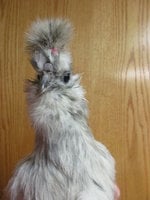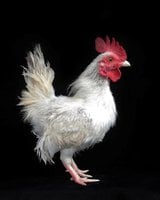I know the are forms dedicated to feed and fermentation, but I really like the local touch of this groupfor all things chicken. I started to ferment feed about a two weeks ago. At first we tried the method of starting a batch and then add we feed some to the hens we added more feed and grain to the mother batch to keep it going. This didn't workot for long. After the first 5 days were started having problems with mold and a horrible stench - things clearly went wrong. Ww have switched to a method of 4 mason jars. 1 jar per day for three days and one in the sink/dishwasher. We feed jar 1 on day 1 and then it goes in to be replaced by jar 4 which is filled with feed, grain and water. Then jar 2 is fed on day 2 and replaced by the now cleaned jar 1. On and on the cycle goes and we end up with a jar of fermented seed everyday that has fermented for 3 days. This works in that tge feed is not overly rotted, but takes on a sourdough odor, softens, and obviously expands. The biggest problem now is expansion. At first we simply left at least an inch of water over the feed/grain mixture. The feed/grain exoanded over the top of the jars though and I had to scoop out about 2 inches everyday - a waste and wet feed/grain exposed to air can lead to mold and other nasty things. I tried ls feed/grain. This sorta worked, but the surface of the water would get funky and sunflower seeds in particular seem to float. So I put lids on the jars. Seemed simple enough. However, the lids are now bulging thanks to gas created by the fermentation process. I don't want some type of bio bomb blowing up in my garage, which is were I am doing this fermentation project - started in the kitchen but after some initial funk I relocated it out of our living space.
So, now I need help from my fellow chickonians (just made that up but it has a nice ring to it). Do you ferment feed? What works for you? Is there a budget friendly solution to contain the fermenting feed but sllow the gases to release?
I was thinking of a bubbler - drill a hole in each jar lid and insert a hose barb, then submerge the other end of the hose into a container of water. The gases would travel through the house and bubble out of the water. The water would act as a barrier to prevent air coursing mold spores, bacteria, etc from entering the jar. Anybody do anything like this? It reminds me of a DIY CO2 reactor I once created for a planted aquarium.
Tge other problem I would still be left with also is the fermented feed seems too wet for the chickens. They eat everything down to the water, leaving everything that is submerged alone. If I drain the water off they will eat the rest. Anybody havea solution to this? Different feeding dish maybe that allows the water to run off or a cleaner way to drain the fermented feed? It just clogs a mesh strainer and yhat becomes s nightmare to clean.
home depot or lowes had 1 gal food safe buckets.. but what works for your situation, is best
1/4 teaspoon of ground red pepper per bird is a therapeutic dose .. flakes don't seem to dissolve , the ground doesn't dissolve either but it spreads through the mix better
most people say to feed grit and oyster shell free feed, some birds need more than others.
If your birds have soft eggs or gain too much weight, cut back on the treats: the extra cracked corn and supreme bird food... lots of fats in those... and they may be filling up on them and not getting good nutrition from the layer feed...treats are usually 10% OR LESS of a chickens diet.
https://www.backyardchickens.com/threads/chick-treats.1262819/#post-20272871
https://www.backyardchickens.com/articles/chicken-treat-chart—the-best-treats-for-backyard-chickens.47738/
this link is for production birds not dual purpose and is the minimums.. my birds do better on higher protein...
show people have show bird formulas that is higher than this link.
https://www.nap.edu/read/2114/chapter/4
also a member share a reciped he uses
It's very cool that this conversation has come up and I'm excited to participate in it and also of course as always to learn more.
We've been fermenting feed for a couple months now and it's going great. We do it in 5 gallon buckets.
We're still tweaking our plans but so far this is how it's going and what we've done. Then I'll tell you what werew researching and planning to try.
Our birds love the fermented feed and and having over 100+ birds not counting all the spring chicks makes feed costs a problem for us. I really need to go through and get an exact count of the adult flock. This has made our feed use and costs go down but we are still tweaking the amount we feed.
We were getting a 20+% mash from our local feed mill but they closed in March this has made things dificult only in that we are having trouble finding the protein we want for a price we can afford. Ideally we want a higher protein feed we can feed to all of our birds(chickens quail guineas and turkeys-once grown). Without a doubt our chickens do not do as well on a lower protein feed. While some continue to thrive some begin to lose weight.
Currently we have been feeding 18% mash although have also had to make do several times with only a 16% layer. This is of course only what's being fed to the adult birds.
Now pellets and crumbles pretty much turn to mush when fermented so that makes no difference. Mash as well pretty much does the same.
We've been using the three bucket method with 5 gallon buckets. Two buckets nested with the inner bucket having holes in the bottom for drainage. A small amount of the feed does seep into the bottom bucket and each bucket is started over every third day. That is to say when the bucket gets fed it is removed from the outer bucket and left to drain for a couple hours in the yard. The outer bucket is dumped in the yard after the inner is removed and the chickens eat the food bits off the ground. We have a pig feed trough in one of our coops we have talked about using but as of yet spread the fermented feed on the ground as it encourages the birds to forage more. Most of our flock are great foragers but we do have some lazy birds in the flock as well.
As an added bonus feeding them in the yard/or being able to move them to where we want them to eat has added benefits. Some of which including cropping the grass, preventing weed growth, tilling soil etc.
We dug most of our potatoes last week and have been able to feed them on the freshly dug Earth allowing them to also make the most of bugs, worms and grubs that were exposed and has kept weeds from coming up.
I would definitely suggest looking into finding some smaller food grade buckets to ferment feed in. We do lay lids on top even shut them a little but we don't shut them tightly. Any bugs that are dumb enough to climb in add to the protein. We have never had trouble with mold. Each bucket after it's fed is sprayed clean with the hose and started again.
We haven't decided what room we will ferment the feed in come winter right now the buckets are on our well pump slab.
We did originally add acv with the mother to each batch of fermented feed to help start it but DH2B noticed that it fermented the same without it in the heat of the summer.
We are also looking into mixing and fermenting a whole grain feed ration and will be picking up bags for a trial run this weekend. I forget but I believe the feed mix in question is used by Justin Rhodes who is a YouTuber. We are also researching and looking up a number of other mixes.
As well as this last weekend we were told by our feed guys that someone is thinking of renting the feed mill from them that is a few blocks from our house that we used to use. Which would be a huge blessing.


 mine is supposed to close today, but they didn't get to my last order yet. They are going to mill it next week, which is good because I bought 3 months worth of turkey (what my little suv will hold) a couple of weeks ago, and had 2 months already before they sent the notice. So I will put some in the freezer, because it gets stale after 6 months. I will have to can tomatoes and meat instead of freezing them this year.
mine is supposed to close today, but they didn't get to my last order yet. They are going to mill it next week, which is good because I bought 3 months worth of turkey (what my little suv will hold) a couple of weeks ago, and had 2 months already before they sent the notice. So I will put some in the freezer, because it gets stale after 6 months. I will have to can tomatoes and meat instead of freezing them this year. and I need away to unload a truck
and I need away to unload a truck 





